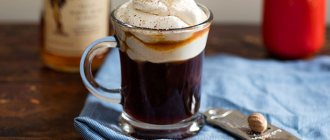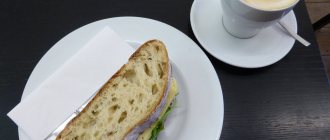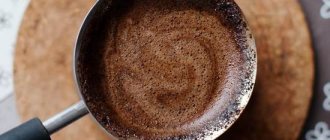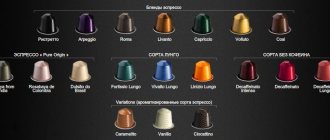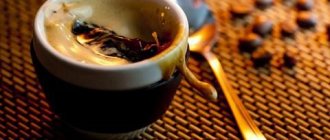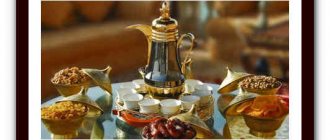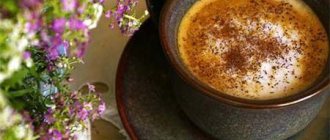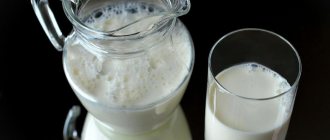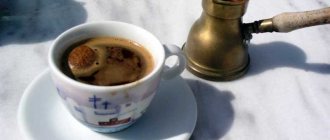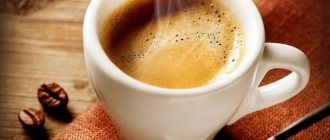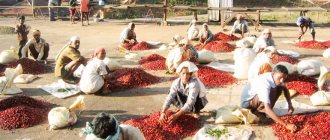The essence of preparing a decoction from ground coffee beans is quite simple. Extraction occurs under the influence of hot water. Over the course of coffee history, man has invented numerous ways to brew coffee. Some came to us from the darkness of centuries, and some have much more modern origins. Let's do a little revision of the basic methods of preparing your favorite drink, what if we find something particularly interesting?
Brewing coffee in a Turk
The classic way to brew coffee is to brew it in a Turkish coffee pot. In the very first versions, the role of the Turk was played by a saucepan with a long handle. It was replaced by the Arabic dallah coffee jug. He was so popular that in some countries there are monuments to him. Then the Arab entertainers created the Turka, which successfully spread throughout the world.
This device is called a cezve, and they began to call it a Turk in Russia due to the fact that visiting representatives of the Turetsk region did not part with this dish.
The method of brewing in Turk has not changed for many centuries. Coffee is placed in a heated vessel, filled with water and heated until foam rises. The classic requires heating the drink in hot sand or on hot stones, but our contemporaries prefer to use gas or electricity.
Brewing a coffee drink using a homemade muslin filter
But how to make ground coffee without a Turk and without a French press? You can try to make a homemade filter from available materials.
You might be interested in Chili Coffee
You will need:
- coarse coffee;
- mug (preferably transparent and narrow);
- rubber bands for money;
- piece of muslin.
Instructions
Step 1. Cut a circle from clean fabric, the radius of which should be approximately 1.5 times the height of the cup. You can draw a bright dot in the center of the circle.
Step 2. Place the fabric in the cup so that the bright dot is directly in the center of the bottom. Wrap the extra fabric over the edges of the cup and secure it on top with elastic bands. The fabric filter must be attached to the sides very tightly (you can additionally use paper clips or a binder).
Step 3. Place 2 tablespoons of coarsely ground grains on a cloth and add hot water. At this stage there is a danger that the filter will slip off, so it is better to hold it with your hand.
Step 4. Leave the drink to brew for 3-4 minutes. Then carefully remove the elastic bands and lift the fabric from the thickener. The aromatic coffee will remain in the cup.
Drip method
The development of engineering could not ignore the area of coffee preparation. Repeated attempts to mechanize the process were crowned with the first success at the very beginning of the 19th century, when the prototype of the modern drip coffee maker first appeared.
This method involved dripping pre-heated water rather slowly through the ground coffee. The extraction process took longer, resulting in a stronger drink.
This principle still underlies all existing drip coffee makers today.
Preparing ground coffee using a French press
The most popular and inexpensive device for making coffee (after the Turk) is undoubtedly the French press. Under the complex name lies a cylindrical glass carafe and a piston with a special stainless steel mesh filter.
List of what you need:
- French press;
- measuring spoon;
- coarse ground coffee.
Instructions
Step 1. Boil water and let it sit for 3-4 minutes. Cool boiling water cannot be used to prepare a drink in a French press. Firstly, this may spoil the taste, and secondly, the glass of the press itself may burst.
Step 2. Rinse the glass vessel with hot water. Add coarsely ground coffee in the amount of one tablespoon per 300 - 400 grams of water.
Note: It is correct to brew coffee in a French press only if the grinding of the beans is very coarse and coarse. Otherwise, the strainer will become clogged and a large amount of sludge will end up in the cup.
Step 3. Slowly pour hot water over the coffee. Lower the piston until the filter stops two centimeters above the water level. After about 2-3 minutes, lower the piston to the very bottom. This way, the grounds will be at the bottom, and a clean, aromatic drink will remain above the filter, which can be poured into cups.
Tip: It is necessary to prepare ground coffee in exactly the amount needed for one use. You cannot leave a drink prepared in a press for several days. It is better to pour filtered coffee into a thermos.
Siphon for brewing coffee
In the 20s of the last century, the French, who then had impressive scientific potential, came up with a funny new product - a siphon for brewing coffee, built on the principle of sublimation. Coffee was also poured into a filter and placed on the top of the device. The lower flask was filled with water and heated from below. The top layer of water was squeezed out by the bottom, boiling, into a flask with coffee. Active seething began, but not boiling. Then the heating was stopped, and the cooled liquid slowly flowed down through the filter. After a few minutes, the resulting drink had a very mild taste. The funny thing is that the French quickly forgot their new toy, but it was preserved in Asia, where it is actively used for making both coffee and tea. A few decades later, the siphon returned to the Europeans, and now baristas put on real shows with it.
A geyser coffee maker is the best alternative to a Turkish coffee maker
A geyser-type coffee maker is an excellent solution for those who do not want to bother with a Turk, but at the same time want to brew ground coffee correctly. The device consists of three different cameras. The first chamber is located at the bottom and is filled with purified water. After turning on the device, pressure is built up in this chamber, which allows water to rise into the second compartment. The middle chamber has the shape of a funnel (this is where the ground coffee is poured). In the third compartment the finished drink is collected directly.
It is the geyser coffee maker that allows you to get a drink that, in its taste, will be as similar as possible to Turkish coffee.
Of course, this is quite old-fashioned, and not as convenient as using bags or a French press. However, many connoisseurs claim that coffee prepared using this method is the most aromatic and rich. A logical question arises: why are geyser coffee makers not too popular?
You might be interested in Coffee “Monkey Tail”
Firstly, although the coffee tastes rich, it may not be to everyone's taste. If you overdo the amount of ground beans, the drink will turn out bitter, and if you add too much water, it will be tasteless. Secondly, this particular method takes much more time than all of the above. It is also necessary to constantly monitor the coffee maker, which is not very popular for busy people (it is much easier to buy a fully automatic device).
Cold coffee in a cup
One of the most modern methods can rightfully be considered revolutionary. Coffee is poured not with hot, but with cold water. True, you should be patient, the extraction process in this case takes about 16-18 hours. But the drink turns out to be very strong, incredibly invigorating and at the same time incredibly soft.
As for recipes for brewing coffee, there are countless of them. Based on water and milk, with the addition of cream, spices, fruits, liqueurs, sugar. Cocoa, chocolate and even... cheese are added to coffee for taste. So here you have all the cards in your hands - feel free to experiment and find your own way of preparing your favorite drink.
Drip packages
We are used to tea bags, but it turns out that coffee can also be in bags! And you can brew it the same way: by pouring boiling water over it. The advantage is that there will be no sediment left in the cup (if you compare, for example, with cupping - simply brewing coffee in a cup). But keep in mind that some sachets are very tightly packed with coffee, this makes the drink less strong. Another disadvantage of this method is that the bags sometimes give a specific taste. And, of course, you have no control over which grains are used for filling.
Drip packet with coffee
Brewing laws
To brew good coffee, in addition to quality beans, you will need knowledge of the laws of brewing. When water comes into contact with ground coffee, the most interesting and important process begins to occur, which is called extraction - the flavoring and aromatic components pass from the grain into the water, and we get an aromatic drink with a unique bouquet of flavor shades.
Extraction may be under or over. If there is not enough coffee, it will turn out unbalanced, with sharp acidity. If too much, the coffee will be very bitter.
Here are a few factors that influence the extraction process and general recommendations on how to optimize them:
Grinding degree - the coarser the beans are ground, the longer the coffee needs to be brewed, and vice versa.
Amount of coffee - the recommended ratio for brewing is 60 grams of coffee per 1 liter of water. You can measure exactly once, with a scale, how much fits in your teaspoon (about 4 grams) and then use it as a measuring tool, calculating the required portion.
Water temperature - coffee should not be brewed with boiling water, since in this case the extraction is very active, the drink will contain a lot of caffeine and bitterness, and subtle flavoring and aromatic substances will evaporate upon contact with boiling water. The optimal temperature is 93-94 degrees. At home, you can do this - boil a kettle, wait a couple of minutes, and only then use the water to brew coffee.
Water quality - if the water is hard, like in Moscow, then it is better to use bottled water. In St. Petersburg there is enough filtered water; our water is softer.
COFFEE (COLLECTION OF RECIPES)To prepare the drink at enterprises of the highest category, it is necessary to carry out additional roasting of natural roasted coffee (beans). Coffee is fried in thick-walled cast iron frying pans or baking sheets, pouring a layer of 2-3 cm and stirring continuously so that the beans do not burn, for 8-10 minutes at medium heat on the stove burner.
Roasted coffee beans are ground in special mills (coffee grinders). It is recommended to grind coffee immediately before preparing the drink, as ground coffee quickly loses its aroma. It should be taken into account that coarsely ground coffee retains its aroma better than finely ground coffee, it is easier to settle from the grounds and the drink is more transparent. To prepare oriental coffee, served with grounds, the beans should be ground very finely; they must pass through a metal sieve with a mesh size of 0.63 or 0.40 mm or through a finer sieve.
Before preparing coffee in special coffee pots, they are first rinsed with boiling water, ground coffee is added (according to the norm), poured with boiling water and allowed to stand for 5-8 minutes.
When produced in electric coffee makers, coffee is added per 1 liter of drink. Ground coffee is poured into the machine’s mesh 5-6 minutes before the water boils. During the brewing process, flavoring and aromatic substances are extracted from coffee. To improve the taste of the drink, leave the coffee in the machine for 5-8 minutes.
The finished coffee is poured into coffee pots or directly into coffee cups, glasses with or without cup holders and served.
Instant coffee is prepared only in coffee pots according to demand. Coffee is poured with boiling water and stirred.
You can use natural instant coffee, packaged in bags.
Black coffee is dispensed in 100 ml quantities, sugar is supplied separately in the amount of 15 g, as well as lemon with a net weight of 7 g. Depending on demand, coffee can be dispensed in 200 ml quantities.
Coffee with milk, condensed milk, canned milk, coffee drink is sold in 200 ml.
716.
Coffee black
| I | II and III | |
| NET | NET | |
| Coffee natural | 60 | 40 |
| Water | 1140 | 1100 |
| or natural instant coffee | 20 | 10 |
| Water | 1030 | 1030 |
| Exit | 1000 | 1000 |
Brew and dispense black coffee as described above.
717.
Coffee with milk
| I and II | III | |
| NET | NET | |
| Coffee natural | 40 | 30 |
| or coffee natural with chicory | 40 | 30 |
| 375 | 250 | |
| Water | 715 | 840 |
| 125 | 100 | |
| Exit | 1000 | 1000 |
Brew coffee black, strain, add hot milk, sugar and bring to a boil.
718.
Coffee with condensed milk
| Coffee natural | 40 | 30 |
| or coffee natural with chicory | 40 | 30 |
| Whole condensed milk with sugar (canned) | 140 | 95 |
| 60 | 55 | |
| Water | 955 | 995 |
| or sterilized condensed milk (canned) | 170 | 115 |
| 125 | 100 | |
| Water | 920 | 980 |
| Exit | 1000 | 1000 |
Add condensed milk and sugar to brewed, strained black coffee, stir and bring to a boil.
719.
coffee drink
| NET | |
| Coffee drink “Friendship”, “Extra”, “Narodny”, etc. | 40 |
| Water | 860 |
| 100 | |
| 250 | |
| Exit | 1000 |
The coffee drink powder is poured with boiling water (including the addition of milk) and brought to a boil. After settling (3-5 minutes), the drink is poured into another container, sugar is added, hot milk is added and brought to a boil again.
720.
Warsaw style coffee with milk
| Coffee natural | 8 |
| or coffee natural with chicory | 8 |
| Water | 120 |
| 25 | |
| Baked milk | 100 |
| Milk for foams | 85 |
| Exit | 200/ |
______________
* Weight of foam obtained from 85 g of milk.
Add sugar and hot baked milk to the strained black coffee and bring to a boil. Before serving, add hot milk foam, skimmed off when heating the milk, into the coffee.
721.
Oriental coffee
| NET | |
| Coffee natural | 10 |
| 15 | |
| Water | 105 |
| Exit | 100 |
Finely ground natural coffee is poured into a special container (turk), sugar is added, poured with cold water and brought to a boil. Coffee is served in a Turkish cup or poured into coffee cups and filtered. Cold boiled water is served separately.
Upon special order, oriental coffee is prepared without sugar.
722.
Black coffee with ice cream (glazed)
| I and II | |
| NET | |
| Black coffee No. 716, ml | 100 |
| 15 | |
| Creamy or milk ice cream or ice cream | 50 |
| Exit | 150 |
Sugar is added to the finished black coffee and cooled to 8-10°C. When dispensing, coffee is poured into a glass, wine glass or conical glass, a scoop of ice cream is added and served immediately.
723.
Black coffee with lemon and cognac or liqueur
| Black coffee No. 716, ml | 100 |
| 15 | |
| Lemon | 8/7* |
| Cognac | 25 |
| or liquor | 15 |
| Yield: with sugar, lemon and cognac | 100/15/7/25 |
| with sugar, lemon and liqueur | 100/15/7/15 |
______________
* The numerator indicates the gross mass, the denominator indicates the net mass.
The coffee is brewed black and served as directed. Lemon and sugar are served on a rosette; cognac and liqueur - in a glass.
724.
Black coffee with whipped cream Viennese style
| I and II | |
| NET | |
| Black coffee No. 716, ml | 100 |
| 15 | |
| Whipped cream No. 682 | 30 |
| Exit | 130 |
Sugar is added to the finished black coffee. When on vacation, add whipped cream to a glass or cup of coffee.
COCOA AND CHOCOLATE (COLLECTION OF RECIPES)
Cocoa and chocolate are prepared in containers specially designed for this purpose. Cocoa and chocolate are dispensed in 200 ml cups or glasses.
725.
Cocoa with milk
| I | II | III | |
| NET | NET | NET | |
| Cocoa powder | 35 | 25 | 20 |
| 900 | 650 | 500 | |
| Water | 140 | 400 | 550 |
| Sugar -sand | 150 | 125 | 100 |
| Exit | 1000 | 1000 | 1000 |
Cocoa powder is mixed with sugar, a small amount of boiling water (100 ml) is added and ground into a homogeneous mass, then with continuous stirring, pour in hot milk, the rest of the boiling water and bring to a boil.
726.
Cocoa with condensed milk
| II | III | |
| NET | NET | |
| Cocoa powder | 25 | 20 |
| Whole condensed milk with sugar (canned) | 245 | 190 |
| 15 | 15 | |
| Water | 820 | 880 |
| or sterilized condensed milk (canned) | 300 | 230 |
| 125 | 100 | |
| Water | 750 | 820 |
| Exit | 1000 | 1000 |
Sweetened condensed milk or sterilized condensed milk (without sugar) is diluted with hot water and brought to a boil. The drink is prepared as indicated in the recipe. No. 725.
////////////////
